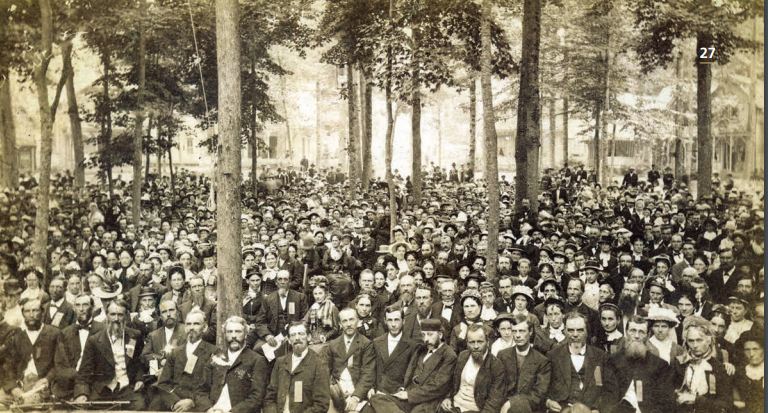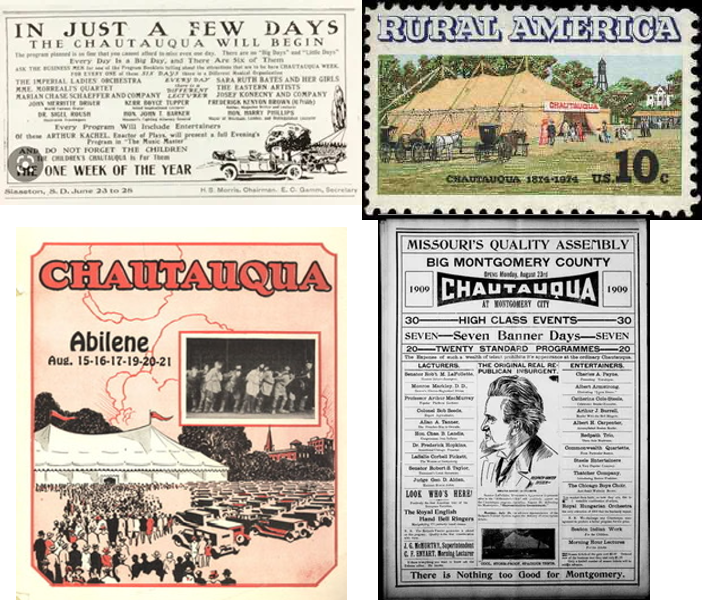This past summer the Chautauqua Institution in New York state celebrated its 150th anniversary. Your response to this news might be “So?” Would it surprise you to learn the Chautauqua Institution made a major impact on the development of agricultural and extension education, but its impact has gone largely undocumented. The intent of this Footnote is to acquaint the profession with Chautauqua and start to document the impact it had on the development of agricultural and extension education. It belongs in our family tree along with the likes of Farmers Institutes, agricultural societies, corn clubs, and the Smith-Lever and Smith-Hughes Acts.
.png)
What is Chautauqua?
Chautauqua might be defined as a gathering of people who want to be educated, entertained and inspired by accomplished experts in a variety of topics in a beautiful outdoor setting during the summer months on the shores of Chautauqua Lake in New York State. However, that definition would be lacking.
During the nine-week summer session of Chautauqua there are typically 7,500 people in attendance daily on the 750 acre campus. They might listen to lectures on important topics of the day and enroll in classes ranging from art, music, photography, culinary arts, religion and philosophy, to fitness, dance, history, literature and writing. They might also engage in recreational activities such as golf, pickleball, shuffleboard, sailing, boating, fishing and swimming.
The GoErie website says that Chautauqua is known as a community of artists, educators, thinkers, faith leaders and friends dedicated to exploring the best in humanity, the institution in New York state is also a place to see a great show. The shows (and many lectures) take place in the 4,000 seat amphitheater
During the evenings attendees are entertained with operas, concerts, theatrical productions, and popular musical performances such as the Mormon Tabernacle Choir, Wynton Marsalis, Steve Martin and the Steep Canyon Rangers, Bonnie Raitt, Diana Ross, Frankie Valli, Patti LaBelle and the list goes on.

Figure 2. The “Amp” at the Chautauqua Institution.
A theme for each week of the summer session provides direction for the speakers and programming for the week. Some of the weekly themes from the past three summers include:
- The Evolution of the Modern Presidency
- The AI Revolution
- Water: Crisis, Beauty, and Necessity
- Exploring the Transformative Power of Music
- A Life of Literature
- The National Parks
- The Global South
- The Wild: Reconnecting with Our Natural World
- What Should be America’s Role in the World?
- Home: A Place for Human Thriving
When I am asked to describe Chautauqua, I often say, “A summer camp for the intellectually elite.” Chautauqua is really hard to describe; one has to experience it to fully understand. There are numerous videos about Chautauqua ranging from a short 3 minute sampling to a 56 minute documentary. I would encourage you to block out an hour and enhance your education by watching the 56 minute video.
How Did Chautauqua Get Started?
Lewis Miller, a Sunday School leader in Akron, Ohio and Rev. John Vincent, a Methodist minister, were concerned about how poorly prepared Sunday School teachers were in the 1870s. In an effort to improve the teaching skills of the Sunday School teachers they decided to conduct a two-week long class on Sunday School teaching on the shores of Chautauqua Lake in western New York state.
This event was held in early August of 1874 and attracted some 20,000 attendees during the two-week span. People camped out in tents. Lectures, classes and recreational activities were held. The assembly was a great success.
 Figure 3. Attendees at the first Chautauqua Assembly in 1874.
Figure 3. Attendees at the first Chautauqua Assembly in 1874.
The event was repeated the following year and for years thereafter with additional components being added. People started building permanent cottages on the grounds. By 1879 the season had expanded to 43 days and lengthened to 60 days by 1899. Various departments were added to provide in-depth instruction in subjects such as languages, theology, music, physical education (Knute Rockne was in charge), library science (Melvil Dewey who developed the Dewey Decimal System was in charge), liberal arts, dance and art.
In the late 1800s very few people were college graduates, but the general public was eager for education and mental stimulation. After the Chautauqua summer session was over, the people didn’t want their learning to stop. Chautauqua responded by creating a voluntary reading program known as the Chautauqua Literary and Scientific Circle (CLSC) in 1878.
The Chautauqua Literary and Scientific Circle
The CLSC was a four year plan of required reading. The premise was that individuals would receive the same amount of information as a person who had a four-year college degree. At the end of four years the CLSC completers would receive a diploma. To ensure that the readings had been completed tests were administered.
About half of the CLSC readers were reading by themselves. The other half had formed local circles where they would meet and discuss their readings. Some locales had as many as five different reading circles. Des Moines had 30 reading circles at one time (Thornton, 1950).
Membership in the first class of CLSC reached more than 8,000. In 1891 Reverend Vincent reported that 180,000 members were enrolled. By 1900 some 10,000 reading circles had been started. By 1918 the total enrollment exceeded 300,000.
CLSC reading circles were found around the world, even in prisons. There were reading circles in Japan, South Africa, Russia, Hawaii, England, Zimbabwe. Argentina, Ceylon, India, Korea, Labrador, Ceylon and in many more places. There was even a Chickasaw Circle in Indian Territory.
An article published on June 16, 1911 in the Charlotte Observer (p. 2) stated “A large number of the graduates are people who have heretofore been deprived of educational advantages and the pleasure and profit they have derived from this systematic course of home study is incalculable.”
Copycat, Circuit, Tent or Traveling Chautauquas
Because of the success of the New York Chautauqua many cities across the country established their own Chautauquas. Not everyone could travel to New York. Hugh Orchard in his Fifty Years of Chautauqua book has a list of independent Chautauquas that existed in 1904. He identified 159 Chautauquas in 30 states. But there were still more to come. Feratie in his 2017 doctoral dissertation (p. 3) stated there have been close to 500 daughter or independent Chautauquas. An article in the New York Times in 1914 said there were 600.
Several issues emerged in the early 1900s that impacted the Chautauqua Movement. Many small communities were too small and lacked the resources to establish permanent or daughter Chautauquas. The second problem was scarcity and competition for talent. With 500-600 daughter Chautauqua there were bidding wars for top level talent and many of the Chautauquas were at the same time, in the summer. And the great distance between the various Chautauquas was also a problem.
To remedy this situation entrepreneurs put together packages of talent and would travel from town to town in rural America staging Chautauquas. There were at least 50 companies operating 93 traveling Chautauqua circuits in the United States and Canada in the 1920s. The traveling Chautauqua would sign a contract with a town requiring the locals to guarantee the sales of x number of tickets. Several of the circuit Chautauquas used special trains for moving equipment and talent around.
 Figure 4. The Redpath Chautauqua Train.
Figure 4. The Redpath Chautauqua Train.
The traveling Chautauquas were typically 7 days in length, with some being up to 10 days or as little as three days. There was substantial publicity prior to the arrival of the Chautauqua. When the Chautauqua arrived, a huge tent was set up and a canvas fence was put around it to prevent people without tickets from observing the proceedings. The arrival of the Chautauqua was a big thing.
Gould (1961, p. 82) stated that circuit Chautauquas were held in eight thousand communities and more than half of the residents bought season tickets. Hurlbut stated there were 10,000 circuit Chautauquas held in 1919. The University of Iowa has a fabulous digital online collection of artifacts related to the traveling Chautauquas. They say (2001) “By the mid-1920s, there were twenty-one circuits providing programs in more than 10,000 communities in 45 states to an estimated 40 million people.” Some sources say there were as many as 12,000 circuit Chautauquas held in a year.
 Figure 5. The Postal Service issued a stamp commemorating 100 years of Chautauqua in 1974. The other images are advertisements for various Chautauquas.
Figure 5. The Postal Service issued a stamp commemorating 100 years of Chautauqua in 1974. The other images are advertisements for various Chautauquas.
Interim Concluding Remarks
When we combine the impact of the New York Chautauqua, the daughter Chautauquas, and the circuit Chautauquas combined with the CLSC, their impact on America and the world is enormous. The purpose of this Footnote is to build the foundation for several Footnotes that will follow that focus on the impact of the Chautauqua Movement on agricultural and extension education. While many people would view Chautauqua as a liberal arts focused entity, it did have a significant, but largely undocumented impact on the development and practice of agricultural and extension education.
It was my privilege to be the wrap up speaker for the 150th celebration of the Chautauqua Institution this past summer. I was specifically asked to focus on the historical impact of Chautauqua on the world. The title of my presentation was “Go Ye Into All The World: Stories of the Chautauqua Movement and its Legacy.” I identified 25 unique contributions that Chautauqua had made on the world. Some of these included the right of women to vote, adult education practices, establishment of local libraries, camp fire girls, national defense, Parent Teachers Associations, physical education, university summer schools, playgrounds and athletic fields, teacher education, university presses, women’s clubs, and the list goes on. One could even make the case that Rice Crispy Treats were a by-product of Chautauqua.
What surprised me during my research on Chautauquas was the impact they had on agricultural and extension education. I had no idea. Next week we will start our exploration of these impacts.
References
Ferati, Ferki (2017). The Rise and Decline Of The Chautauqua Movement And Its Lessons For 21st Century Civic Adult Education. Doctoral Dissertation. University of Pittsburgh. https://www.proquest.com/docview/1984977538/fulltextPDF/FB575D28F6E848A1PQ/1?accountid=12725&sourcetype=Dissertations%20&%20Theses
Gould, Joseph E. (1961). The Chautauqua Movement; An Episode in the Continuing American Revolution. State University of New York.
Hulbert, Jesse Lyman (1921). The Story of Chautauqua. G. P. Putnam’s & Sons, Boston.
Orchard, Hugh (1923). Fifty Years of Chautauqua. The Torch Press. Cedar Rapids, Iowa.
Thornton, H. J. (1950). Chautauqua in Iowa. Iowa Journal of History, 50(2). 97-122.
